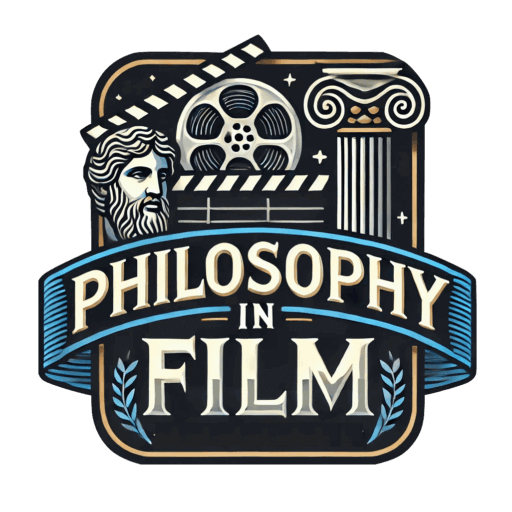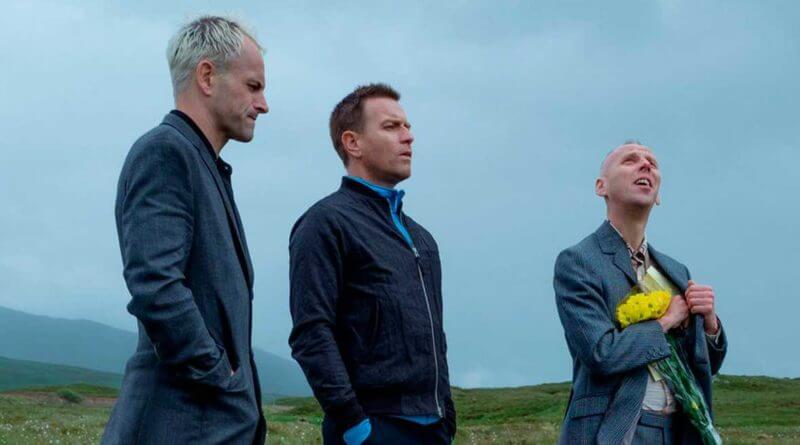The Rise and Fall of Danny Boyle: From Shallow Grave to T2
Danny Boyle has had a prolific career spanning three decades, earning one Academy Award win, three nominations, and great success at the box office. His films have generally been praised by critics, often for their unflinching portrayals of the darker side of humanity, in conjunction with their unique visual style and stimulating soundtracks. Roger Ebert described Trainspotting as a film that knows the truth of addiction “in its very bones (Ebert). More recently, A. O. Scott of the New York Times hailed 127 Hours as “nearly flawless,” specifically praising Boyle’s “knack for tackling painful, violent, or unpleasant subjects with unremitting verve and unstoppable joie de vivre” (Scott). Needless to say, not all of Boyle’s work has been met with such high praise. Variety’s Derek Elley characterized A Life Less Ordinary as a “movie that has everything except an involving storyline and characters,” (Elley). And while Peter Bradshaw of The Guardian venerates Boyle’s artistic abilities and labels him as a “National Treasure,” he denounces his film Trance as “a disappointment,” particularly for its distracting soundtrack, “wild overacting…[and] self-admiring macho violence” (Bradshaw).
Though there have certainly been ups-and-downs in Boyle’s career, it is apparent that it has seen an overall downward trajectory from its promising start. This trend can be traced by evaluating the different periods within Danny Boyle’s career (though for the purposes of this essay, Boyle’s early work in television will be excluded). First, there were the earliest films, in effect a Golden Age for Boyle, lasting from 1994 to 1997. Following this Golden Age was the first blockbuster and initial departure from his earlier style, The Beach (2000). From 2002 to 2004, there was a resurgence in Boyle’s work and a return to his earlier aesthetic. Then, Boyle focused almost entirely on big blockbuster films with very little resemblance to his early films. This period lasted from 2007 to 2015.
Finally, in 2017, Boyle directed Trainspotting 2, which embodied a nostalgia for his earlier works, without actually utilizing the same ideology or style underpinning those films. While Boyle began his career utilizing a unique, frenetic style that seamlessly blended European art film aesthetics with reverence to the more familiar, marketable American Hollywood cinema, he slowly transitioned into a filmmaker whose style has become watered-down, and at times completely eroded by larger budgets, overt commercialism, and an abandonment of the punk-rock aesthetic that made his early work so praiseworthy.
Danny Boyle’s Early Films: “The Golden Age”
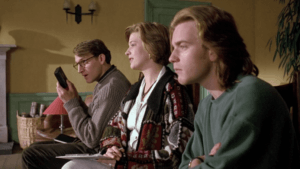
Boyle’s first feature film was Shallow Grave (1994). It was also the first of many collaborations with producer Andrew Macdonald, writer John Hodge, editor Masahiro Hirakubo, and actor Ewan Mcgregor. The story recounts the dark tale of three flatmates in need of a fourth. After reviewing many applications and holding frivolous interviews with the applicants, they eventually agree on a mysterious stranger named Hugo. However, not long after Hugo has moved in, they discover his dead body from an apparent drug overdose, along with a briefcase full of money. The trio argue about how to handle the situation, but eventually decide to secretly dispose of the body and keep the money for themselves. While things seem to go as planned at first, they are not the only ones who know about the money, and the three friends quickly succumb to paranoia and infighting as gangsters and police close in.
Two years later, Boyle would once again team up with Macdonald, Hodge, Hirakubo and Mcgregor to make one of his most acclaimed films, Trainspotting, based on the novel of the same name by Irvine Welsh. In Trainspotting, the central character, Mark Renton, is a heroin addict trying, but generally failing to get clean. Besides getting high, his only other comfort in life is the camaraderie he shares with his friends: Sick Boy, Spud, Tommy, and Begbie. Their collective relationship with heroin eventually leads to Tommy’s death, as well as a high-stakes drug deal which threatens to tear the group apart.
Finally, in 1997, again coordinating with the same creative team, Boyle directed A Life Less Ordinary. One of the most peculiar and polarizing of Boyle’s films, A Life Less Ordinary is a romantic comedy with some elements of fantasy. The story follows Robert, a down-on-his-luck janitor who is suddenly fired from his job. In a moment of desperation, Robert confronts the head of the company, and during a heated exchange, decides to kidnap his boss’ daughter, Celine (played by Cameron Diaz). This leads the pair on a series of misadventures, all while two angels from heaven, O’Reilly and Jackson, attempt to make them fall in love.
Needless to say that, while each film carries its own unique brand of Boyle’s artistic vision, his first three films were all created under similar conditions. First and foremost, all three starred Ewan Mcgregor either as the main character or one of the central characters, and were produced using the same creative unit. They were all primarily shot in the United Kingdom, and finally, two of the three films were shot on very low budgets ($2.5 million and $3.5 million respectively). Though A Life Less Ordinary had a much higher cost ($12 million), it was still shot on a lower budget than every one of Boyle’s films produced thereafter.
From these similar conditions, a stylistic pattern emerges. This pattern can be broken down into the following creative techniques and methodologies:
- An affinity for dark comedy
- Surreal, often disturbing imagery
- A view into characters’ mental states (often through point-of-view shots, narration, and dream sequences)
- Graphic violence
- Use of very high/low angle shots
- Urban settings
- Deference to the conventions of European Art Cinema, namely jump cuts, non-active protagonists with vague or contradictory traits, unbalanced staging, and non-linear timelines.
- A series of very short, frenetic shots juxtaposed with long shots
- Generally fast-paced, energetic storytelling (accompanied and enhanced by fast-paced editing)
- Bizarre, disorienting, or even seemingly impossible camera placement
- Stories focused on crime, often involving the acquisition of money through illegal means
- Use of strong, bright colors, either through lighting or colorful set decoration
- A blend of Scottish, English, and American cultural influences and filmmaking practices
This final point is perhaps the most difficult to define, but also the most vital when evaluating the quality of Boyle’s work. As has been argued before, Scottish national identity is problematic in and of itself, so too is identifying Scottish cultural signifiers or filmmaking practices, as the culture and practices are so heavily influenced by outside forces (namely England and the United States). The qualities that make Danny Boyle’s first few films uniquely Scottish are few, but nonetheless present. First, Boyle’s focus on urban settings is in line with much of Scotland’s film and television programming (Sim and Leith). And second, with a culture that is overwhelmed by outside influences, one of the only signifiers left is that which separates a member of any one culture from another. Put simply, language and dialect serve as the primary signifiers of a Scottish film. Both Shallow Grave and Trainspotting are set and shot in Scotland, using (mostly) Scottish actors, utilizing Scottish accents and colloquialisms. In A Life Less Ordinary, this is done to a much lesser degree. The film is not set in Scotland, and the majority of actors in the film are American. However, the central character is still played by a Scottish actor (Mcgregor) employing a Scottish accent. As for English and American influences on these films, they are most evident in the soundtracks, primarily consisting of American and English punk rock bands, and the visual style, which generally blends the practices of the European Art Cinema with the more marketable “Classical Hollywood” style of editing, lighting, staging, and framing. The characterization fits more closely with that of European Art Cinema, insofar as character motivations are often vague, and the protagonists do not always evoke audience sympathy or identification. And, despite his early work showing an appreciation for all things Scottish, Danny Boyle is English, ultimately contributing to the cultural patchwork that embodied his early work.
The First Blockbuster: The Beach

Following the critical success of his early films, notwithstanding A Life Less Ordinary’s poor showing at the box office, Boyle directed The Beach, an adaptation of the novel of the same name by Alex Garland. The film stars Leonardo DiCaprio as Richard, a young American backpacking through Thailand. Richard meets an eccentric man who goes by the name Daffy Duck (played by Robert Carlyle). He gives Richard a map to an island that he describes as an untouched paradise. Following Daffy Duck’s abrupt suicide, Robert goes to the island, only to find that he is not the first to arrive, and it is not quite as idyllic as he had hoped.
Though much of Boyle’s creative team remained intact for The Beach, this would be his first film not to star Ewan Mcgregor, a fact that caused a rift between the two for more than a decade. It was also his first big-budget film, costing approximately $50 million to produce. Despite these changes, the film does retain a few of the same qualities as his earlier works, with a decidedly greater use of traditional American editing and narrative structure. Richard is a clearly defined, goal-oriented protagonist who moves the plot forward. And with the exception of a few jarring, surreal scenes, namely a sequence in which Richard is shown as the lead character in a video game, the majority of the film is shot using classical Hollywood techniques for spacing, framing, lighting, and editing. Critics generally panned the film, stating that the beautiful locales couldn’t make up for it being a mediocre adaptation.
Resurgence: A Return to the Early Aesthetic
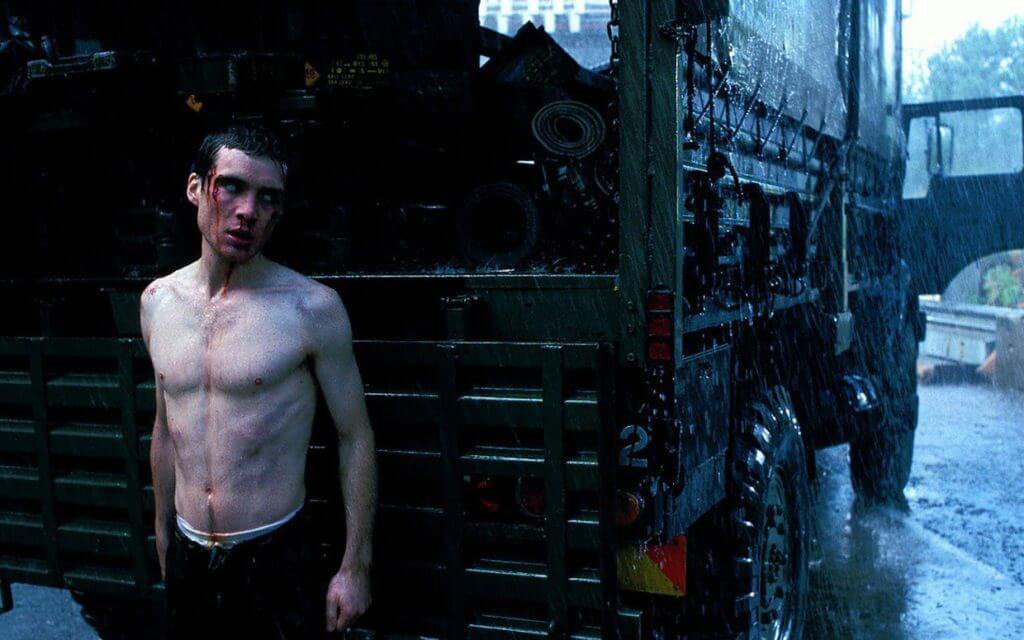
Following the disappointment of his first blockbuster, Boyle directed the zombie-apocalypse film, 28 Days Later (2002) on a meager $8 million budget. Alex Garland wrote the screenplay, and though Andrew McDonald stayed on as a producer, Boyle shed the remaining members of his creative team. 28 Days Later tells the story of a man named Jim (Cillian Murphy) who wakes up in an abandoned hospital. Jim ventures out into the deserted streets of London, only to realize that most of the remaining citizens are afflicted with a virus that causes extreme, mindless rage. Seeking shelter, Jim meets another group of survivors, with whom he attempts to evade the swarms of infected and find safety.
In 28 Days Later, Boyle implements a style that bears a greater resemblance to his earlier films, primarily through his use of a fast-paced editing, graphic violence, bright colors, frequent high and low angle shots, and an aesthetic and narrative structure that resemble the European Art Cinema more so than the Classical Hollywood Cinema. Though the film functions within the more predictable frameworks of the horror genre, specifically those qualities of a zombie apocalypse film (the constant threat of danger, startling sound spikes, “impure” monsters, a large horde of zombies vs. a small group of survivors, among others), it distinguishes itself by eschewing the more familiar qualities of the Hollywood visual style.
Two years later, Boyle directed Millions, a comedy-drama about a young boy, Damien, who discovers a large sum of money, which he thinks was sent from God. Believing that he should use the money for good, he attempts to help those in need, but soon finds that the money is a huge burden and causes more harm than good. Though the tone of Millions differs greatly from Boyle’s earlier films (and is his only film not to be given an R-rating), it still maintains the same qualities that distinguish him as an auteur. The film departs from the grittier, violent films that had generally defined Boyle’s career up to that point, instead offering a more contemplative, family-friendly rumination on morality and religion. Nonetheless, Danny Boyle still utilizes surreal imagery, disorienting camera placement, and, even with its moralistic overtones, a narrative that seamlessly blends American and European styles.
The Blockbuster Period
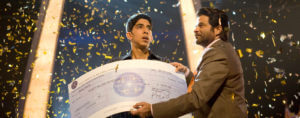
Having established himself as an international director who could cater his films to a variety of audiences, Boyle quickly made the move to bigger budget Hollywood films. Throughout the early 2000’s, he would direct the following films:
- Sunshine (2007), a science-fiction film about a crew attempting to revive a dying sun. (Budget: $40 million)
- Slumdog Millionaire (2008), a story of a young man from the slums of Mumbai, who answers every question correctly on the quiz show, Who Wants to Be a Millionaire?, and is subsequently accused of cheating. (Budget: $15 million)
- 127 Hours (2010), retells the true story of a man who, while hiking in the canyons of Utah, falls into a slot canyon and gets his arm trapped by a boulder. (Budget: $18 million)
- Trance (2013), a film about an art thief who suffers a head injury during a heist, causing him to forget where he hid the stolen artwork. (Budget: $20 million)
- Steve Jobs (2015), the true story of the co-founder of Apple. ($30 million)
While not universally praised by critics, most of these films were met with critical acclaim, and a few garnered prestigious awards. However, despite all of the praise and attention that these films brought to him as a filmmaker, they also embodied Boyle’s complete departure from his own roots, and the departure from the filmmaking style and practices that gave him such a meteoric rise in the first place. All of these films share similar qualities that are markedly different than those of his previous films:
- Larger budgets
- Visual spectacle is given precedence over style or narrative
- Dialogue is primarily used to move the plot forward
- A greater emphasis on drama, with very few instances of dark comedy
- Each film, in terms of style and narrative form, is virtually indistinguishable from other directors’ films of their respective genres
This last quality is perhaps the most crucial when evaluating the direction that Boyle’s career has taken. With only a handful of exceptions, much of what made Boyle’s early work (and brief resurgence) so praiseworthy is absent in his blockbusters. The influence of the Classical Hollywood style of filmmaking, combined with the allure of larger profits, led Boyle to adopt the practices of more traditional narrative forms at the expense of his own style. As a result, these large budget, Hollywood productions look remarkably similar to other contemporary films of their genres.
Trainspotting 2: Nostalgia Devoid of Style
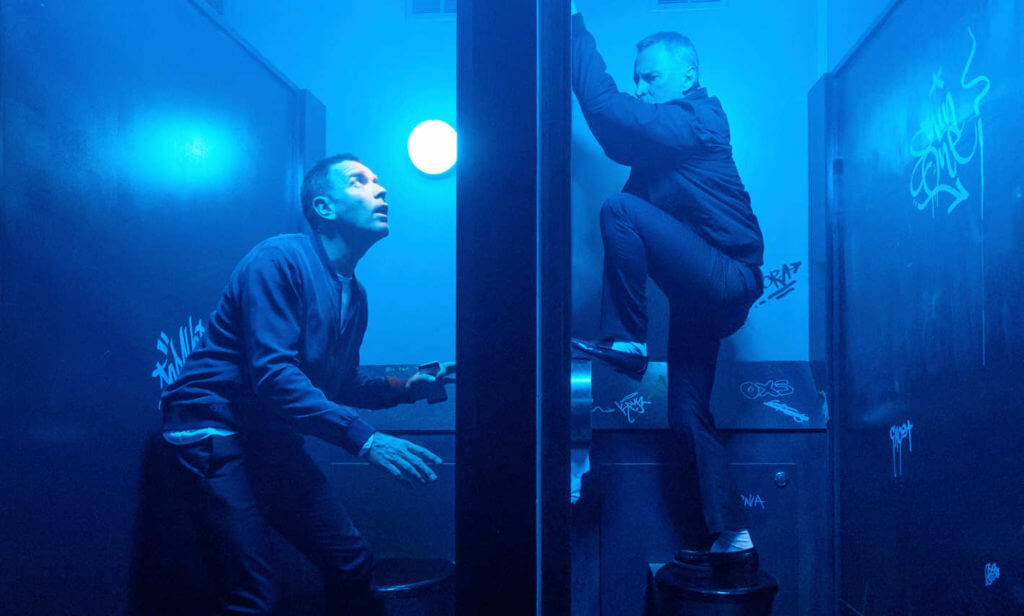
In 2017, the long-awaited sequel to Trainspotting was released, with the same principle cast from the original reprising their roles. The screenplay was adapted from Irvine Welsh’s followup to Trainspotting, Porno, which looks at the same characters 10 years after the events of the first novel (though in the film version it is meant to be 20 years after the original to coincide with the actual time that had passed since Trainspotting’s release). Mark Renton, having stolen a large sum of drug money in the first Trainspotting, finally returns to his home in Edinburgh. He comes back to find that Spud has been unable to kick his addiction to heroin, and has essentially hit rock bottom. Sick Boy owns a bar, but continues to carry out illegal schemes in his spare time. And though Begbie has been serving a 25 year prison sentence, he manages to escape, and is hellbent on exacting revenge for Mark’s betrayal. Mark agrees to assist Sick Boy in his schemes, all while attempting to save Spud from himself and avoid detection by Begbie.
Though the plot distinguishes itself from the original in a few small ways, T2 is a film primarily about nostalgia. The characters, having wasted the last 20 years of their lives, and being displeased with the outcome, try desperately to cling to the carefree nihilism and freedom of their youth. So, too, does Danny Boyle. Throughout Trainspotting 2, we are reminded of what a superior film the original Trainspotting was, and Boyle seems to know it. The film clings to the genius of the original, trying to recapture the magic, but it never really works. Boyle once said that “[the cinema] remains a young man’s medium,” (Boyle). While he was generally referring to viewership, and the power that the cinema can have over young, impressionable minds, it can be equally applied to the art of filmmaking. He is an older filmmaker, trying to make films that the younger Danny Boyle would appreciate. But like any old man trying to impress cynical young men, he fails miserably. Everything in T2 feels disingenuous, a mere shadow of the genius and craftsmanship that went into the original Trainspotting. T2 is a film that is constantly searching for identity, and, finding nothing of the sort, must fall back on the laurels of its predecessor. Trainspotting was, in a sense, searching for an identity, but only insofar as Scottish national identity is a complex thing to define and capture, and thus Trainspotting was a uniquely Scottish film. But T2 lacks identity not due to any preexisting societal circumstances, nor for any artistic vision on Boyle’s part, but because it hardly functions as a stand-alone narrative. The film constantly recycles shots from the original, and lazily references lines and broader concepts, as if to say, “remember how great Trainspotting was?”
The anti-materialist diatribes that blended so seamlessly with the punk-rock aesthetic of the original (which was made on a paltry budget of about $3.3 million USD after adjusting for inflation), now ring hollow and untrue, given the film’s $18 million budget, in conjunction with product placements for Viagra and references to large social media brands. Boyle even recycles the now infamous “Choose Life” speech from the beginning of the original Trainspotting, just to update it with timely references to Snapchat and Instagram, a half-hearted attempt to criticize the addictions of the modern era; but none of it is wholly original, nor is it particularly profound or interesting in its social critique. While Trainspotting’s message is reflected in its tone, style, and modes of production, T2’s musings are marred by an overabundance of nostalgia, materialism, and faux-progressivism.
Although Trainspotting made good use of lighting and cinematography that both represented and enhanced Renton’s frenetic mental state, T2 offers nothing original in its mise en scène. The lighting in T2 merely mimics the original, rather than enhancing the style or calling attention to Boyle’s artistry. In Trainspotting, the lighting is most often standard three point setups, with more unique coloration inserted sporadically, generally for scenes demonstrating Mark’s mental state, or club scenes in which the extreme neon and flashes of light are justified. But in T2, brief shots involving bright, neon-colored lighting are quickly thrown onto the screen with no real narrative or thematic justification. As a result, the entire film feels like a muddled display of color, without clear purpose or direction.
While Danny Boyle had a meteoric rise and a very promising career, he was taken in by the allure of Hollywood. Like so many other directors, Boyle’s genius was squandered for the sake of making products that appeal to the largest possible demographic, at the expense of artistry and quality auteurship. Though Boyle will surely continue to produce critically-acclaimed films in the future, it is doubtful that his work will ever recapture the lost genius of his youth.
If you are interested in watching any of the aforementioned films, they are available to rent or purchase via Amazon at the following links:
Shallow Grave, Trainspotting, A Life Less Ordinary, The Beach, 28 Days Later, Millions, Sunshine, Slumdog Millionaire, 127 Hours, Trance, Steve Jobs, Trainspotting 2
Boyle, Danny. Interview by Robert K. Elder. The Film That Changed My Life by Robert K. Elder. Chicago: Chicago Review Press, 2011. N. p28. Print.
Bradshaw, Peter. “Trance – Review.” The Guardian, 28 Mar. 2013, www.theguardian.com/film/2013/mar/28/trance-review.
Ebert, Roger. “Trainspotting.” Roger Ebert, Ebert Digital LLC, 26 July 1996, www.rogerebert.com/reviews/trainspotting-1996.
Elley, Derek. “A Life Less Ordinary.” Review of A Life Less Ordinary. Variety, 19 Oct. 1997, variety.com/1997/film/reviews/a-life-less-ordinary-1200451478/.
Scott, A. O. “The Tale of a Shocking Fall and a Gritty Resolve.” The New York Times, The New York Times, 4 Nov. 2010, www.nytimes.com/2010/11/05/movies/05one.html.
Sim, Duncan, and Murray Stewart Leith. The Modern Scottish Diaspora: Contemporary Debates and Perspectives. Edinburgh University Press, 2014.
